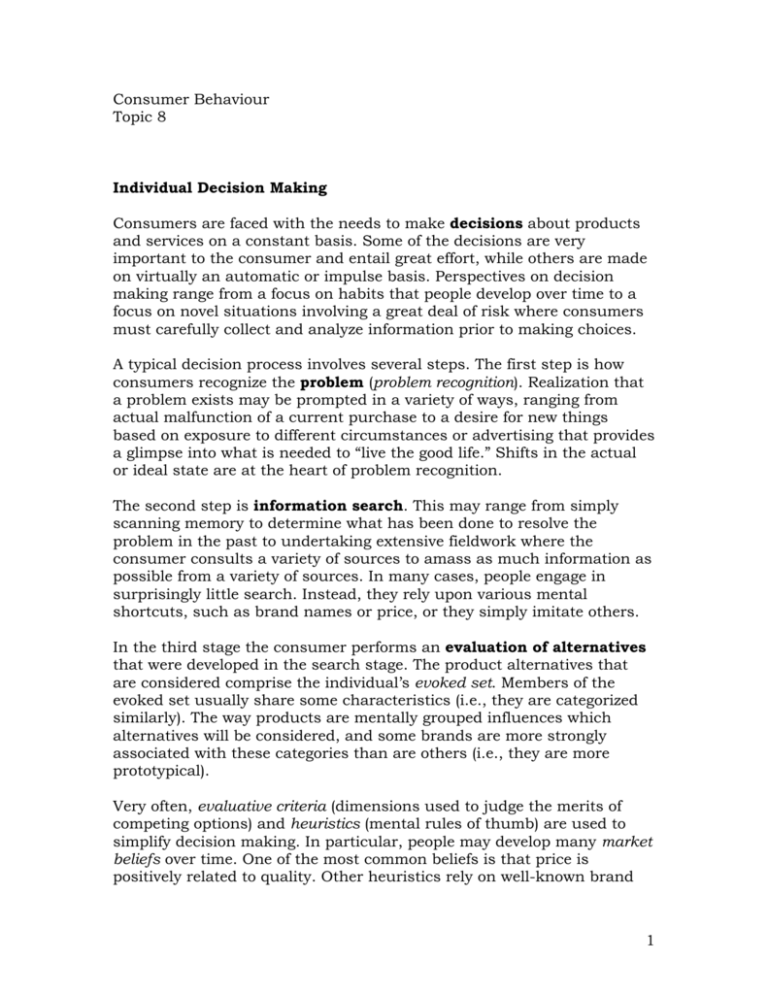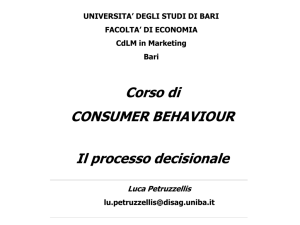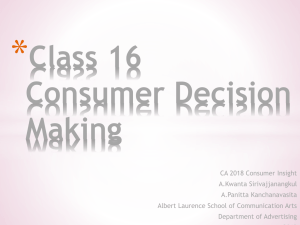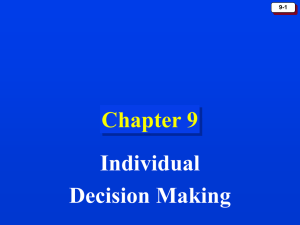Consumer Behaviour
advertisement

Consumer Behaviour Topic 8 Individual Decision Making Consumers are faced with the needs to make decisions about products and services on a constant basis. Some of the decisions are very important to the consumer and entail great effort, while others are made on virtually an automatic or impulse basis. Perspectives on decision making range from a focus on habits that people develop over time to a focus on novel situations involving a great deal of risk where consumers must carefully collect and analyze information prior to making choices. A typical decision process involves several steps. The first step is how consumers recognize the problem (problem recognition). Realization that a problem exists may be prompted in a variety of ways, ranging from actual malfunction of a current purchase to a desire for new things based on exposure to different circumstances or advertising that provides a glimpse into what is needed to “live the good life.” Shifts in the actual or ideal state are at the heart of problem recognition. The second step is information search. This may range from simply scanning memory to determine what has been done to resolve the problem in the past to undertaking extensive fieldwork where the consumer consults a variety of sources to amass as much information as possible from a variety of sources. In many cases, people engage in surprisingly little search. Instead, they rely upon various mental shortcuts, such as brand names or price, or they simply imitate others. In the third stage the consumer performs an evaluation of alternatives that were developed in the search stage. The product alternatives that are considered comprise the individual’s evoked set. Members of the evoked set usually share some characteristics (i.e., they are categorized similarly). The way products are mentally grouped influences which alternatives will be considered, and some brands are more strongly associated with these categories than are others (i.e., they are more prototypical). Very often, evaluative criteria (dimensions used to judge the merits of competing options) and heuristics (mental rules of thumb) are used to simplify decision making. In particular, people may develop many market beliefs over time. One of the most common beliefs is that price is positively related to quality. Other heuristics rely on well-known brand 1 names or a product’s country of origin as signals of product quality. When a brand is consistently purchased over time, this pattern may be due to true brand loyalty or simply to inertia because it’s the easiest thing to do. When the consumer eventually must make a product choice from among alternatives, a number of decision rules may be used. Non-compensatory decision rules eliminate alternatives that are deficient on any of the criteria the consumer has chosen to use. Compensatory decision rules, which are more likely to be applied in high-involvement situations, allow the decision maker to consider each alternative’s good and bad points more carefully to arrive at the overall best choice. Lecture Outline 1. Consumers as Problem Solvers a. Most consumers go through a series of steps when they make a purchase. They are: 1) Problem recognition 2) Information search 3) Evaluation of alternatives 4) Product choice a) Learning occurs on how well the choice worked out. b) This learning affects future choices and purchases. b. Because some purchase decisions are more important than others, the amount of effort we put into each differs. 1) Sometimes the decision is almost automatic. 2) Sometimes the decision is one where a great deal of thinking and analysis is required. Perspectives on Decision Making c. Traditionally, consumer researchers have approached decision makers from a rational perspective. In this view, people calmly integrate as much information as possible with what they already know about a product, painstakingly weigh the pluses and minuses of each alternative, and arrive at a satisfactory decision. 1) Though this approach is correct in many instances, it does not describe all forms of decision making. Sometimes actions may be contrary to those predicted by rational models. 2) Purchase momentum occurs when initial impulses increase the likelihood that we will buy even more than we need. 3) Consumers probably have many strategies for making decisions. This is called constructive processing. 2 4) Environmental cues may be used (such as buying on impulse). This form of decision making is called the behavioural influence perspective. 5) In other cases, consumers are highly involved in a decision, but still the decisions cannot wholly be explained rationally. This is called the experiential perspective. This approach stresses gestalt (or totality) of the product or service. Marketers in these areas focus on measuring consumers’ affective responses to products or services and develop offerings that elicit appropriate subjective reactions. Types of Consumer Decisions d. Decision processes can be considered by the amount of effort that goes into the decision each time it must be made. Three forms exist: 1) Extended Problem Solving—There is a fair degree of risk and we use internal search and external sources. The consumer tries to collect as much information as possible. Corresponds most closely to the traditional decision-making perspective. 2) Limited Problem Solving—This is a simple, straightforward decision process. Buyers use simple decision rules to choose among alternatives. Cognitive shortcuts are used. 3) Habitual Decision Making—These are characterized as simple automatic decisions. This form is characterized by automaticity where there is a mini effort and an absence of conscious control. 2. Problem Recognition a. Problem recognition occurs whenever the consumer sees a significant difference between his or her current state of affairs and some desired or ideal state. 1) The consumer perceives there is a problem to be solved, which may be large or small, simple or complex. 2) A problem can occur in two ways. a) The quality of the consumer’s actual state (running out of gas, for example can move downward (need recognition). b) The consumer’s ideal state (e.g., desiring a newer flashy car) can move upward (opportunity recognition). c) Either way, a gulf occurs between the actual state and the ideal state. b. Need recognition can occur in several ways: 1) The quality of the person’s actual state can be diminished by: a) Running out of a product. b) By buying a product that turns out to not adequately satisfy needs. c) By discovering new needs. 3 c. Opportunity recognition often occurs when a consumer is exposed to different or better-quality products. d. Although problem recognition can and does occur naturally, this process is often spurred by marketing efforts. 1) Marketers attempt to create primary demand, where consumers are encouraged to use a product or service regardless of the brand they choose. 2) Secondary demand, where consumers are prompted to prefer a specific brand over others, can only occur if primary demand already exists. 3. Information Search a. Once a problem has been recognized, consumers need adequate information to resolve it. Information search is the process in which the consumer surveys his or her environment for appropriate data to make a reasonable decision. Types of Information Search b. Types of search that the consumer may undertake once a need has been recognized include: 1) Prepurchase search—an explicit search for information. 2) Ongoing search—used by veteran shoppers to keep abreast of changes in the product categories of interest to them. c. Information sources can roughly be broken into: 1) Internal search—a memory scans to assemble information about different product alternatives. 2) External search—information is obtained from advertisements, friends, or just plain people-watching. d. Search can be deliberate or accidental. 1) Deliberate search is the result of directed learning—this is an active search. 2) Accidental search is the result of incidental learning—exposure to learning over time (this is a passive search). 4. The Economics of Information a. The traditional decision-making perspective incorporates the economics-of-information approach to the search process; it assumes that consumers will gather as much data as is needed to make an informed decision. 1) Consumers form expectations of the value of information. 4 2) The utilitarian assumption implies that the most valuable units of information will be collected first. 3) Most people, however, do not want to spend long time collecting information. b. Consumers do not always search rationally. Low income consumers search the least. 1) Rational search does not always occur. a) The amount of external search is surprisingly small. 2) Consumers often visit only a few stores before making a decision to purchase. 3) Avoiding external search is less prevalent when consumers consider the purchase of symbolic items. a) Most external search involves the opinions of peers. 4) Consumers are often observed to be in a state of brand switching. 5) This is often caused by a desire to switch (variety seeking) and usually occurs when the consumer is in a good mood. 6) We often switch brands even if we like the old brand. c. There are biases in the decision-making process. 1) A mental accounting can take place. 2) Framing occurs because of the way a problem is posed. 3) The sunk-cost fallacy says that having paid for something makes us reluctant to waste it. 4) Loss aversion says that people put more emphasis on loss than on gain in a situation. An example of this would be prospect theory. 5) There can always be outside influences on our selections. How Much Search Occurs? d. As a general rule, search activity is greater when: 1) The purchase is important. 2) There is a need to learn more about the purchase. 3) The relevant information is easily obtained and utilized. e. Consumers differ in the amount of search they tend to undertake: 1) Females shop more than men. 2) Younger, better-educated people shop more than others. 3) Those who enjoy shopping shop more. f. The consumer’s prior expertise can also affect the search and shopping process. 1) Search tends to be greatest among those consumers who are moderately knowledgeable about the product. 2) The type of search varies with varying levels of expertise. a) Experts use selective search. 5 b) Novices rely on opinions of others and “non-functional” attributes. 3) As a rule, purchase decisions that involve extensive search also entail some kind of perceived risk or belief that the product has potentially negative consequences. Types of risk include: a) Objective risk forms (such as physical danger). b) Subjective factor risk forms (such as social embarrassment). 5. Evaluation of Alternatives Identifying Alternatives a. The alternatives actively considered during a consumer’s choice process are his or her evoked set. In reality, this can be a very small set. 1) The evoked set is composed of those products already in memory (the retrieval set), plus those prominent in the retail environment. Product Categorization b. Product categorization is how consumers organize their beliefs about products or services. This is a crucial determinant of how a product is evaluated. 1) Products in a consumer’s evoked set are likely to be those that share some similar features. 2) This knowledge is represented in a consumer’s cognitive structure (the factual knowledge about products—beliefs—and the way these beliefs are organized in people’s minds). 3) There are several levels of categorization: a) Basic level—items have much in common but a number of alternatives exist. b) Super-ordinate level—abstract concepts. c) Subordinate level—individual brands. c. Product categorization has many strategic implications. Some of these are: 1) Product positioning—The conception of the product relative to other products in the consumer’s mind. To some extent this is how a product is categorized by the consumer. 2) Identifying competitors—Are different products substitutes? 3) Exemplar products—The most known, accepted product or brand. 4) Locating products—Consumers often expect to find certain products within certain places within the store environment. 6 6. Product Choice: Selecting among Alternatives a. Once the relevant options from a category have been assembled and evaluated, a choice must be made among them. Evaluative Criteria b. Evaluative criteria are the dimensions used to judge the merits of competing options. Forms can be: 1) Differences—Significant differences among brands on an attribute (anti-lock brakes). The attributes actually used to differentiate among choices are determinant attributes. 2) Supplying the consumer with decision-making rules. c. When consumers make decisions, marketers often want to impact their decision making. The decision about which attributes to use is the result of procedural learning. To do this (effectively recommend a new decision criteria), the marketer must convey three pieces of information: 1) It should point out that there are significant differences among the brands on the attribute. 2) It should supply the consumer with a decision-making rule. 3) It should convey a rule that can be easily integrated with how the person has made this decision in the past. Cybermediaries d. In cyberspace, simplification is the key. 1) How can people organize the vast amount of information on the Web? 2) One type of business that is growing to meet the demand for information and service on the Web is the cybermediary. This intermediary helps to filter and organize online market information so that customers can identify and evaluate alternatives more efficiently. Collaborative filtering may be used. 3) Forms include: a) Directories and portals b) Web site evaluators c) Forums, fan clubs, and user groups d) Financial intermediaries e) Intelligent agents Heuristics: Mental Shortcuts e. Consumers often rely on heuristics (mental rules-of-thumb that lead to speedy decisions). These rules can be general or specific. Sometimes these shortcuts are not in the consumer’s best interest. 7 f. One frequently used shortcut is the tendency to infer hidden dimensions of product from observable attributes. This can result from: 1) Product Signals—a visible act that signifies underlying quality. 2) Co-variation—perceived associations among events that may or may not actually influence one another. g. Other assumptions include: 1) Market beliefs—knowledge of the market that is used to guide decisions. 2) One of the most pervasive market beliefs is the price-quality relationship. 3) Country of origin as a product signal. a) This is often a signal of quality. b) The consumer must avoid stereotypes. c) The tendency to prefer products or people of one’s own culture over those from another country is called ethnocentrism. h. Branding is a marketing strategy that often functions as a heuristic. 1) Many people tend to buy the same brand just about every time they go to the store. This consistent pattern is due to inertia, where a brand is bought out of habit merely because less effort is required. 2) Brand loyalty is a form of repeat purchasing behaviour reflecting a conscious decision to continue buying the same brand. There is more brand parity today and therefore brand loyalty is harder to achieve (and keep). Decision Rules i. Consumers consider sets of product attributes by using different rules, depending on the complexity of the decision and the importance of the decision to them. j. Simple decision rules are non-compensatory decision rules, meaning a product with a low standing on one attribute cannot make up for this position by being better on another attribute. Rules within this structure can be: 1) The lexicographic rule—the brand with the best attribute is selected. 2) The elimination-by-aspects rule—must have a specific feature to be chosen. 3) The conjunctive rule—the consumer processes products by brand. Cutoffs are established for each brand. Failure to meet one cutoff means the brand will be rejected. 8 k. Unlike non-compensatory decision rules, compensatory decision rules give a product a chance to make up for its shortcomings. You weigh the good points against the bad. 1) There are two basic types of compensatory decision rules: a) Simple additive rules—the consumer merely chooses the alternative having the largest number of positive attributes. b) Weighted additive rules—the consumer considers the relative importance of positive attributes. End. 9







